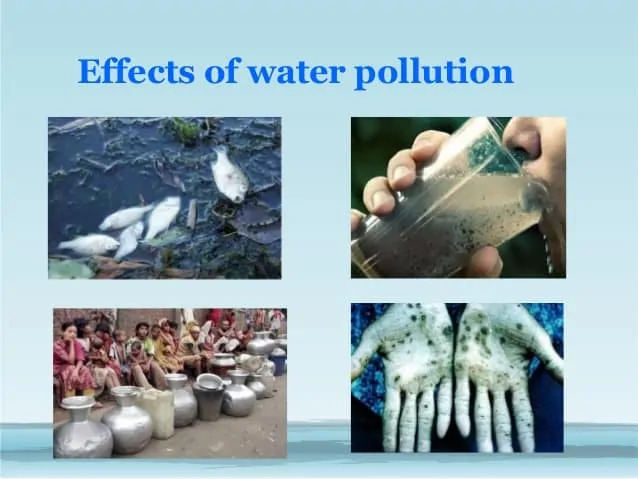Water Pollution Facts

01Causes: Chemicals, waste dumping
02Effects: Sickens or kills organic life
03Types: Surface, ground, nutrient, oil spill
04Deaths: 1,400 deaths daily
05Solutions: Conservation, treatment
06Most Polluted: Lake Karachay
07Biggest Oil Spill: Gulf War
08US Most Polluted: Mississippi River
09US Legislation: Clean Water Act
10World Water Day: March 22
Water Pollution Is Contamination of Bodies of Water
Water pollution facts tell us that sometimes factories, farms and cities dump waste and sewage into local waterways. This causes water pollution by contaminating the water with harmful compounds. Water pollution is also caused when water runoff picks up toxic chemicals, trash and dirt on its way to a tributary.
Water Pollution Affects Plant and Animal Life
Contaminated water adversely affects the plants and animals that live in the water, as well as those that depend on the water for nourishment. This includes humans. If a source of drinking water is contaminated, plants, animals and humans can become ill or die.
Causes of Water Pollution Lead to Contamination
There are several causes of water pollution. At its core, water pollution is the contamination of a body of water. According to water pollution facts, this can happen when sewers empty into rivers, when chemicals from farms run down into water, or when factories and plants dump hazardous waste into waterways. Even rainwater and snow can cause water pollution if it is contaminated by chemicals on rooftops and lawns. Dumping trash into waterways also has negative impacts on the health of the water and the creatures and plants that rely on it.
Multiple Types of Water Pollution Overlap
There a many different types of water pollution and sometimes one type of water pollution may overlap with another. Nutrients pollution is caused by nutrient-rich wastewater finding its way into rivers, lakes, and oceans. The nutrients may help algae and weeds grow, making the water unfit for human consumption and possibly depleting oxygen levels in the water, killing other organic life in the process.
Surface water pollution occurs when chemicals spill into the waterways on the surface of the Earth. Groundwater pollution is when chemicals seep through soil and contaminate water beneath the surface of the Earth. Oxygen-depleting pollution is when oxygen is leached out of the water by too many organisms. Nutrient pollution can lead to oxygen-depleting pollution, just as other types of water pollution converge as well. Other types of pollution include oil spills and suspended matter pollution.
Don’t Litter: Protect Our Water Supply
One way in which we can protect our waterways is to make sure our trash makes its way to a landfill. When trash gets washed away by rain, it ends up in rivers, creeks and lakes, contaminating those waterways. Using safe fertilizers and fewer chemicals on lawns, as well as properly maintaining sump pumps, can help protect against water pollution. On a larger scale, water treatment facilities aim to scale back the contamination of surface water to ensure a supply of safe drinking water and the protection of plants and animals that rely on water sources.
More Than 1,400 People Die From Water Pollution Daily
Though it is hard to calculate the exact extent of such a far-reaching epidemic, it is believed that at least 1,400 people die daily because of water pollution. Water pollution of drinking water can cause infections and diseases, especially in densely populated areas.
Clean Water Act Supports Water Treatment
According to water pollution facts, the Clean Water Act became law in 1972 in the United States. It aims to protect the nation’s waterways by limiting chemicals dumped into waterways and supporting the treatment of the waterways by public organizations.
Clean Drinking Water Is a Global Issue
Polluted drinking water can lead to infection, disease, and even death. In areas with high population density or industrialization, clean drinking water can be hard to come by. Asia, which is home to more than half the world’s population, has some of the most polluted waterways. China, India, and Bangladesh are attempting to treat their polluted rivers in order to protect their citizens and provide clean drinking water.
The Ganges River Is One of the Most Polluted Waterways
The Ganges River provides approximately 40% of India’s drinking water. Although it provides water to so many people, it is also one of the most polluted rivers in the world. The Ganges also an important Hindu holy spot. Millions of pilgrims visit the river each year to wash their feet in it. Water pollution facts indicate the government is considering whether it is even safe enough to continue that ritual.
55% of American Rivers Are Polluted
Water pollution facts show that in 2013 the Environmental Protection Agency released a report stating that 55% of American rivers were in poor condition and could not sustain healthy biological life. Only 21% of American rivers were considered healthy.
Water Pollution Increases Risks of Infection
Polluted water increases the risk of a wound becoming infected, or may lead to a ear, nose or throat infection. Individuals near polluted water should not drink it or swim in it as water pollution can increase the populations of bacteria that cause certain diseases.
Lake Karachay May Be the World’s Most Polluted Lake
Located in Russia, Lake Karachay may be the world’s most polluted lake. The Worldwatch Institute released a report in 2012 that highlighted the dumping of nuclear waste into the lake during the 1950s. Efforts to stem irradiation caused by the pollution have not yet shown themselves to be successful.
